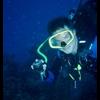Yes, it's through YMCA - one of the better Nitrox courses (and texts) that I have seen. The course is recommended minimum six hours of instruction, and includes a lot of stuff on dive planning, air consumption, etc. There is a significant overlap with some of the traditional topics that are taught in AOW, which is why it made sense to me to combine the lecture portions of the two courses. I added an optional pool session (which I am allowed to do under standards) where I plan to have the students work on buoyancy control, weighting, and some advanced (but not necessarily AOW) skills - SMB deployment, alternative propulsion techniques, etc. I also plan to incorporate some rescue skills (air sharing, unconscious and/or toxing diver rescues, etc). This serves as a review for students who are already YMCA certified, and introduces these concepts to those who are not.I envy you that freedom (I presume that's under YMCA?).
The enrollments will be kept relatively small to insure a more student-focused experience. I also intend to use U/W video during pool sessions to help students learn their skills better. This is something I started doing in my OW course this past year, and I have been very pleased with the results so far.
The actual AOW part (which is "mostly diving") is somewhat decoupled, in the sense that someone who already had AOW from another agency could take this course and still get something out of it. If they do go on and complete the diving portion for the YMCA AOW course, then they get their 5 AOW "skill" dives, plus two Nitrox dives (7 dives altogether, just like what I do for OW). So a person completing the entire two-course sequence winds up with the equivalent knowledge of OW, AOW, Nitrox, and PPB, and has about 15 logged dives to boot. About half of those dives are indirectly supervised, so the students get some experience planning and executing their own dives as well.
So the course serves several purposes - it acts as a sort of "bridge" course for people coming into our curriculum from other agencies, and also provides a comprehensive introduction to mixed gas diving in general, and Nitrox diving in particular. I spent quite a bit of time thinking about how to organize it - it's still very much a "work in progress" so we will see how it goes.
I don't know if it will work yet, so I guess you better hold off before deciding that my approach is better.Given the opportunity I would actually prefer your approach. The sort of thing you could do in a dive club environment, which is one reason I'm considering reviving my BSAC membership/instructorship and forming my dive center into a BSAC club.
-JimG



















